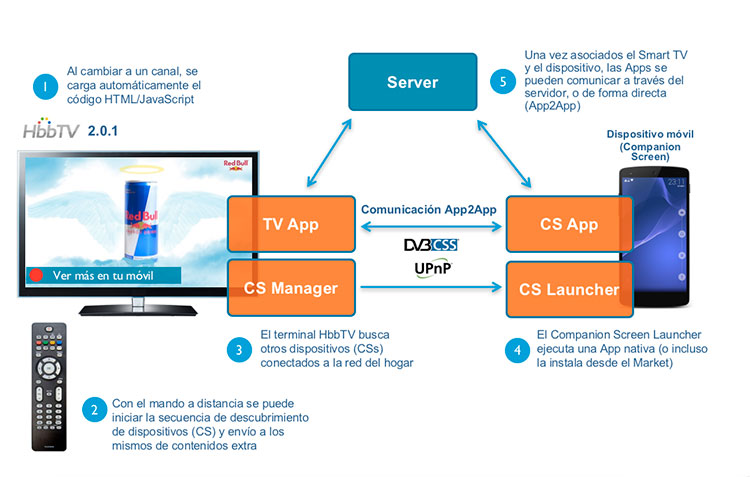Since the appearance of the first digital television services nearly two decades ago, many experiments and initiatives have been carried out to give the viewer the possibility to participate more or less actively in the "TV watching" experience: EPGs or programme guides, games, extra content, etc.
TV Interactivity
However, it was not until the popularization of Smart TVs, with the ability to connect to the Internet and which also allowed downloading and running Apps from the manufacturers' markets, that we began to approach a truly interactive television.
It seemed to be a model destined to have a good reception, since for some years we, the users of smartphones and tablets, have been accustomed to this concept of "App" and to downloading them from the Apple and Google stores, which offer us millions of options for entertainment, leisure, productivity, etc.
However, in Smart TVs the range of applications and their use is much lower than in mobile devices, for two main reasons:
- The context in which a television is used (at home, in a group, with a remote control, etc.) considerably reduces the spectrum of apps that are likely to be attractive in this area.
- TV manufacturers have their own operating systems and development platforms so despite the efforts of the Smart TV Alliance to standardize the development of Apps (its motto is "Build Once, publish everywhere"), creating an App that can be distributed in the stores of different manufacturers is still a complicated process.
On the other hand, this interactive TV model is quite good from the point of view of OTT service providers (Netflix, Youtube, HBO, etc.), but for broadcasters and other actors in the ecosystem (advertisers, developers, etc.) it may not be the most suitable.
Hybrid TV
Fortunately, interactive TV isn't just Apps and Stores...
HbbTV (Hybrid Broadcast Broadband TV) is a platform defined by the global HbbTV Association initiative, which combines television broadcasts with a fiber or ADSL (broadband) Internet connection to offer viewers interactive applications and services.
It is based on existing and well-known standards: DVB, OIPF, W3C (HTML, CSS, Javascript), etc. and designed to be independent of manufacturers' proprietary operating systems and environments.
Moreover, although it is perfectly compatible with the App Stores model, it allows to do something extremely interesting that was not possible until now:
On Smart TVs with HbbTV the simple act of changing channels causes the TV to download and execute HTML/JavaScript code from a URL that travels on the broadcast signal of the channel in question.
This type of application runs in a browser "overlay" on the content being broadcast live, as opposed to traditional Apps, which are accessed through a specific menu, and must come pre-installed or be downloaded from a Store.
Typically, a TV channel's HbbTV application starts up when the channel is tuned in, collects data that identifies the TV and (optionally) displays a small banner overlay on the broadcast content for a few seconds.
The banner usually tells the viewer that they can press the red button on their remote control to access the rest of the application. It can also display information about the program being broadcast, notifications, etc.
With these capabilities, it is not difficult to see that the possibilities that HbbTV technology offers to broadcasters and advertisers are enormous:
- Real-time audience measurement of your channels
- Extra content related to the content being broadcast
- Customized advertising for different segments of the audience
- Social Networking
- …
HbbTV services have been operating for some years now, not only in Europe (this initiative was born in France and Germany), but also in certain parts of Asia, Australia and New Zealand.
In Spain, a country where almost half of the televisions are SmartTV, and of these 75% support HbbTV (source: AEDETI), almost all groups and TV channels, both private and public, are making use of this technology in one form or another.
While for the time being the private television channels use HbbTV's capabilities almost exclusively for audience measurement, it is the public channels, RTVE, TV3, ETB, and to a lesser extent Telemadrid and other regional channels, that are implementing the most interesting use cases and applications:
- Television "a la carte"
- Podcasts and HQ broadcasts of radio programming on TV
- News highlights, sports results
- Pop-up channels for special events (Olympic Games, Elections, Highlights, etc.)
- Subtitles based on EBU-TT-D, alternative audio (audio descriptions), and other applications for accessibility
- Big Data Analytics
HbbTV 2.0, new capabilities, new opportunities
However, this scenario is likely to change, as we saw in the last edition of the HbbTv Symposium (entitled "Open for Business"), which we attended along with other representatives of technology companies, television manufacturers, members of the HbbTv Association and AEDETI, heads of television stations and production companies, marketing and advertising directors, and advertisers from around the world. During the symposium, the scope and status of the HbbTv 2.0 standard was analyzed, and the issue of monetization of hybrid TV services and the formulas to carry it out were addressed with special emphasis.
At the end of 2015 the HbbTV Association published the HbbTV 2.0 specification, which added several improvements over HbbTV 1.5, including
- Evolution of the Stack Web, adopting HTML5/DOM3/CSS3 as standard, and adding established capabilities such as WebSockets, Web Workers and Web Storage
- Evolution of the Streaming Stack, adopting MPEG-DASH in its version 2.0
- Evolution of the Interactivity Stack, incorporating the capabilities of synchronization and communication between TV and mobile devices (Companion Screens)
This last point, and taking into account that according to IAB Spain's Annual Mobile Marketing Survey 2016, more than 80% of TV viewers use a Smartphone while watching TV (this figure is around 56% for tablet use), is especially interesting for applications in advertising and other forms of monetization, which are sure to attract the attention of advertisers, agencies and, therefore, marketing and advertising managers of private TV channels.
Integration of TV with mobile devices
We cannot forget that a television application must be created with the viewer's experience in mind, taking into account that we interact in a very different way with a television than with a PC, tablet or smartphone.
Therefore, the integration of the TV App with a mobile device opens a huge range of possibilities and capabilities, allowing to take advantage of the huge audiences generated by television to initiate experiences that can conclude in the companion screen, which has a user interface much more versatile than a remote control. Some examples are:
- Transmedia and multi-device narratives
- Couponing
- One-click shopping
- Viralization in social networks
- Enrichment of the user profile, adding the data from the mobile device to their TV content consumption habits: applications used, geolocation, etc.

Interactive TV is a new channel
It is very likely, therefore, that with the capabilities offered by the new HbbTV 2.0.1 version, adopted by the Digital Television Technical Forum as a standard for the Spanish market in March 2017 and which will start to be commercially available from 2018, interactive television will start to be seen as a real and effective communication channel, widely used by public and private television channels, advertisers and viewers.At Future Space we have been experimenting with interactive television for some years now, having developed numerous proofs of concept with HbbTV (1.1.1 and 1.5) and synchronization with mobile devices, as well as numerous advertising campaigns and applications in the field of IPTV.












